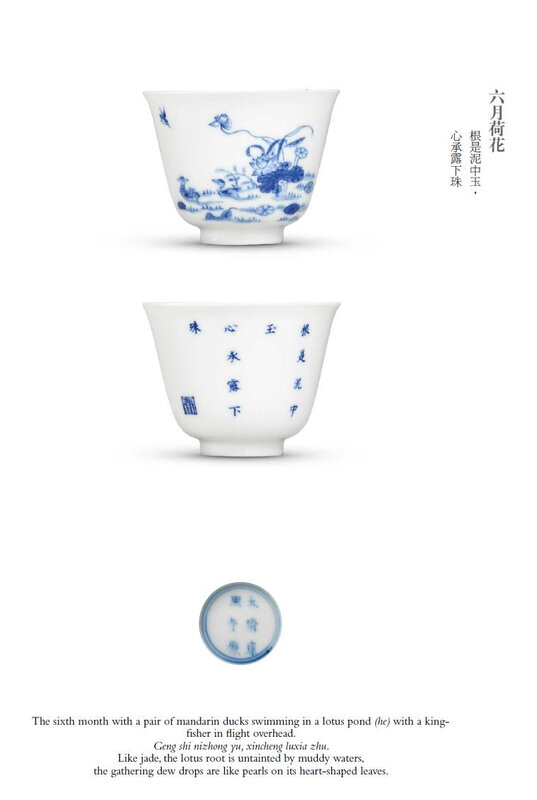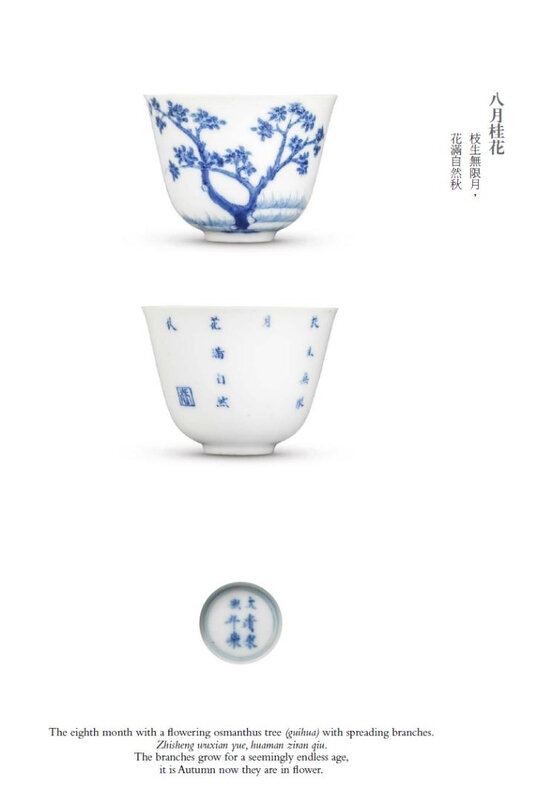Christie's. Important Chinese Ceramics and Works of Art, Hong Kong, 28 november 2018
An extremely rare and fine set of twelve blue and white ‘Month’ cups, Kangxi six-character marks in underglaze blue within doubl
Lot 2908. An extremely rare and fine set of twelve blue and white ‘Month’ cups, Kangxi six-character marks in underglaze blue within double circles and of the period (1662-1722); 2 7/16 in. (6.5 cm.) diam. each. Estimate On Request. Price realised HKD 36,100,000. © Christie's Images Ltd 2018
Each cup is delicately potted to eggshell thinness, the exterior superbly painted in cobalt blue with emblematic flowers representing each month, the reverse of each inscribed with a seasonal couplet by a Tang poet terminating with a seal mark shang(appreciation).
Note: This delicate set of cups is known as ‘month’ cups. Each cup is decorated with a different floral design representing the twelve months of the lunar calendar, complemented by a different poem with relevance to the particular flower depicted, ending with the seal reading shang (appreciation). Such intricate combination of painting, poem and seal on a porcelain surface makes these cups highly coveted items among generations of connoisseurs. These cups are also prized for their remarkable workmanship, as each is so thinly potted that the cobalt blue decorations on the exterior can be seen through the eggshell thin porcelain from the interior of the vessel.
There has been considerable debate among scholars regarding which cup relates to which month. For example, there are various views on whether the narcissus depicts the eleventh or twelfth lunar month, and whether the prunus depicts the first or twelfth lunar month. The current designation in this catalogue is based on the groupings by Geng Baochang in Ming Qing ciqi jianding, Beijing, 1993, p. 207. This designation was also adopted by the Art Gallery, the Chinese University of Hong Kong, in its 1995 exhibition catalogue Qing Imperial Porcelain of the Kangxi, Yongzheng and Qianlong Reigns, Hong Kong, 1995, no. 21.
The poems inscribed on these month cups are all couplets from Tang dynasty poems. It is known that the Kangxi Emperor was an enthusiast of Tang poems, and ordered the compilation of all recorded Tang poems in the 44th year of his reign (1705). This project came into fruition under the leadership of the official Cao Yin, when Quan Tangshu [A Complete Collection of Tang Poems] was published in 1706, encompassing over 40,000 poems, including a foreword written by the Kangxi Emperor himself. Thus, it is likely that these delicate month cups, decorated with poems favoured by the Emperor, were made during the later period of the Kangxi reign when Quan Tangshu was published, intended to please and delight the Son of Heaven.
It is extremely rare to find a complete set of blue and white Kangxi ‘month’ cups. As early as the late Qing dynasty, the difficulty in compiling a full set of twelve cups was already noted by the contemporaneous connoisseur Chen Liu, who wrote in his book Taoya [Elegances of Ceramics] that “it used to be rather uncommon to be able to find a pair, or four, or six of these Kangxi month cups. Recently the chance is even slimmer to find just one or two of them”.
There are only two other complete sets of blue and white Kangxi ‘month’ cups in private hands. The first one was in the T.T. Tsui Collection, illustrated in The Tsui Museum of Art, Chinese Ceramics IV, Hong Kong, 1995, pl. 105B. The second set was sold at Sotheby’s Hong Kong on 4 May 1994, lot 161 and illustrated in Sotheby’s Thirty Years in Hong Kong, Hong Kong, 2003, no. 263, currently in the collection of the Long Museum in Shanghai.
For other full sets of blue and white ‘month’ cups in public institutions, refer to one in the Palace Museum Collection, illustrated in Blue and White Porcelain with Underglaze Red (III), The Complete Collection of Treasures of the Palace Museum, Hong Kong, 2010, no. 71. There are two published sets in the Nanjing Museum Collection, one illustrated in Qing Imperial Porcelain of the Kangxi, Yongzheng and Qianlong Reigns, Hong Kong, 1995, pl. 21; and one illustrated by Xu Huping, Gongting zhencang- Zhongguo Qingdai guanyao ciqi, Shanghai, 2003, pp. 54-55.
‘Month’ cups are also decorated in the wucai palette, which are considerably more common than the blue and white examples. Complete sets of wucai ‘month’ cups include at least two sets in the Palace Museum, Beijing, one of which is illustrated in Kangxi, Yongzheng, Qianlong: Qing Porcelain from the Palace Museum Collection, Hong Kong, 1989, no. 48; one from the Percival David Foundation now on loan at the British Museum, see Illustrated Catalogue of Qing Enamelled Wares in the Percival David Foundation of Chinese Art, London, 1991, no. 815; one in the Idemitsu Museum of Art, Tokyo, illustrated in Chinese Ceramics in the Idemitsu Collection, Tokyo, 1987, no. 221; one in the Alan Chuang Collection, see The Alan Chuang Collection of Chinese Porcelain, Hong Kong, 2009, no. 40; one was formerly in the T.T. Tsui Collection, sold at Christie’s Hong Kong, 3 November 1996, lot 585; one in the Songzhutang Collection, illustrated in Encompassing Precious Beauty: The Songzhutang Collection of Imperial Chinese Ceramics, Hong Kong, 2016, pl. 18; one formerly in the Meiyintang Collection, currently in a private collection; and one sold at Sotheby’s New York, 23 September 1997, lot 348.
The combination of painting, poem and seal also imbues these Imperial cups with a refined scholarly taste, setting the precedence for the esteemed falangcai wares made during the Yongzheng and Qianlong reigns, on which enamelled decorations, grisaille calligraphy and rouge seals are tastefully combined, creating a distinct, regal style befitting Imperial use.

/https%3A%2F%2Fprofilepics.canalblog.com%2Fprofilepics%2F1%2F0%2F100183.jpg)
/https%3A%2F%2Fstorage.canalblog.com%2F03%2F02%2F119589%2F96711876_o.jpg)
/https%3A%2F%2Fstorage.canalblog.com%2F11%2F31%2F119589%2F94773502_o.jpg)
/https%3A%2F%2Fstorage.canalblog.com%2F20%2F83%2F119589%2F94772815_o.jpg)
/https%3A%2F%2Fstorage.canalblog.com%2F26%2F72%2F119589%2F75604929_o.jpg)
/https%3A%2F%2Fstorage.canalblog.com%2F59%2F60%2F119589%2F26458628_o.jpg)



















/image%2F1371349%2F20240416%2Fob_2a8420_437713933-1652609748842371-16764302136.jpg)
/image%2F1371349%2F20240414%2Fob_83ee65_2024-nyr-22642-0954-000-a-blue-and-whi.jpg)
/image%2F1371349%2F20240414%2Fob_15808c_2024-nyr-22642-0953-000-a-blue-and-whi.jpg)
/image%2F1371349%2F20240414%2Fob_e54295_2024-nyr-22642-0952-000-a-rare-blue-an.jpg)